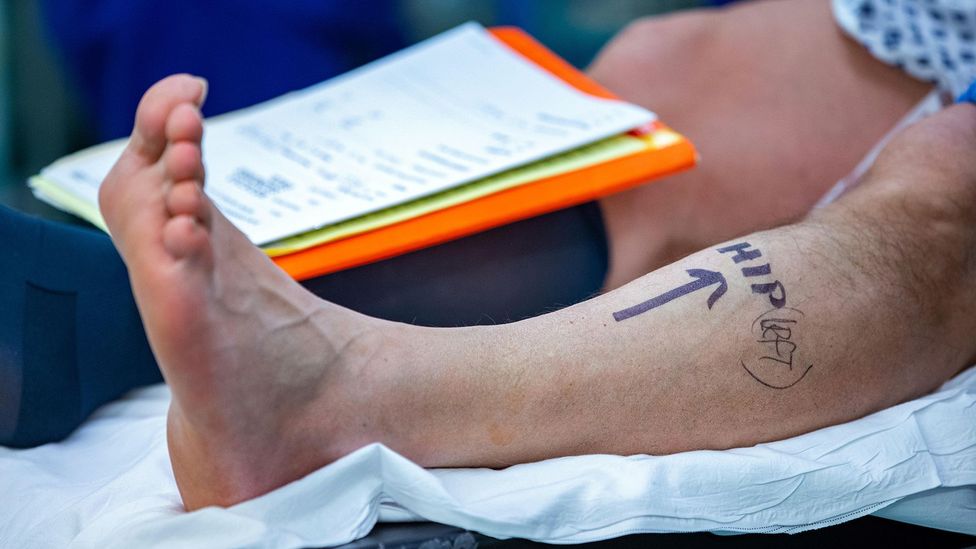When British brain surgeon Henry Marsh sat down beside his patient's bed following surgery, the bad news he was about to deliver stemmed from his own mistake. The man had a trapped nerve in his arm that required an operation – but after making a midline incision in his neck, Marsh had drilled out the nerve on the wrong side of his spinal column.
Preventable medical mistakes frequently involve wrong-sided surgery: an injection to the wrong eye, for example, or a biopsy from the wrong breast. These "never events" – serious and largely preventable patient safety accidents – highlight that, while most of us learn as children how to tell left from right, not everyone gets it right.
While for some people, telling left from right is as easy as telling up from down, a significant minority – around one in six people, according to a recent study – struggle with the distinction. Even for those who believe they have no issues, distractions such as ambient noise, or having to answer unrelated questions, can get in the way of making the right choice.
"Nobody has difficulty in saying [something is] front and back, or top and bottom," says Ineke van der Ham, assistant professor of neuropsychology at Leiden University in the Netherlands. But telling left from right is different, she says. "It's because of the symmetry, and because when you turn around, it's the other way around, and that makes it so confusing."
Left-right discrimination is actually quite a complex process, calling upon memory, language, visual and spatial processing, and mental rotation. In fact, researchers are only just beginning to get to the bottom of exactly what's going on in our brains when we do it – and why it's much easier for some people than others.

Former US President Donald Trump was briefly flummoxed when leaders were asked to cross hands at a summit in the Philippines in 2017 (Credit: AFP/Getty Images)
How being left-handed changes your brain
Around one in 10 people are left-handed, and studies on twins have shown that genetics has a role to play. A study at the University of Oxford recently revealed four regions in human DNA that seem to play a role in determining if someone is left or right handed.
Those who were left-handed were found to have "mutations" in four genes that code for the body's cytoskeleton – the complex scaffolding that sits within cells to help organise them. Scans of people with these mutations showed that the white matter in their brains had a different structure. The left and right sides of the brains of left-handed people were also better connected than in right-handed people.
"Some individuals can tell right from left innately, just can do it without thinking," says Gerard Gormley, a GP and clinical professor at Queen's University Belfast in Northern Ireland. "But others have to go through a process." In an effort to understand what happens in wrong-sided medical errors, Gormley and his colleagues have conducted research on medical students' experience of making left-right decisions and examined the process.
"First of all, you have to orient right from left in yourself," he says. When the answer doesn't come instantly, participants described various techniques, from making an L shape with their thumb and index finger, to thinking about which hand they use to write, or strum a guitar. "For some people it's a tattoo on their body or a piercing," Gormley says.
Then, when figuring out which side is someone else's left or right, the next step is mentally rotating yourself so you're facing in the same direction as the other person. "If I'm facing you, my left hand will be opposite your right hand," says Gormley. "That idea of mentally rotating an object adds an extra degree of complexity." Other research shows that people tend to find it easier to judge if an image shows a left or right hand by imagining their own hand or body rotating.
Research published by Van der Ham and her colleagues in 2020 found that around 15% of people rate themselves as insufficient when it comes to identifying left and right. Almost half of the four hundred participants in the study said they used a hand-related strategy to identify which is which.
The researchers used something called the Bergen right-left discrimination test to dig deeper into how these strategies work. Participants looked at pictures of stick people either facing toward or away from them, with their arms in various positions, and had to identify their highlighted hand as their left or right. "It seems simple, but it's kind of frustrating if you have to do a hundred of these as quickly as you can," says Van der Ham.
In the first experiment, the participants sat with their hands on a table in front of them. "There was a very clear effect from how this little stick figure was positioned," says Van der Ham. "If you were looking at the back of the head, so it was aligned with you, people were a lot faster and more accurate." Similarly, when the stick person was facing the participant but had their hands crossed, so their left hand was on the same side as the participant's left hand, people tended to do better.
"That tells us that the body really is involved in this," says Van der Ham. The next question was whether participants were using cues from their body at the time of the test to identify left and right, or referring to a stored idea of their body instead.
To answer that, the researchers repeated their experiment, but this time tested four different scenarios: participants sat with their hands either crossed or uncrossed on the table in front of them, and had their hands either visible during the test, or covered with a black cloth.
But the researchers found that none of those changes influenced test performance. In other words, participants didn't need to actually see their hands in order to use their own body to distinguish right from left.
"We haven't completely solved the issue," says Van der Ham. "But we were able to identify our bodies as being a key element in identifying left from right, and that we consult our body representation as we have it in a more static way."

Mistakes made during medical procedures due to left-right errors have led some surgeons to take extra steps to ensure they operate in the right place (Credit: Tommy London/Alamy)
In Van der Ham's experiments, the boost in performance that came from being in line with the stick person was more pronounced in people who said they use a hand-related strategy to tell left from right in their daily lives, as well as in women generally. The researchers also found that men tended to be faster in responding than women, but the data did not back up previous research showing that men perform better overall in left-right discrimination tests.
You might also like:
- Why time goes forwards and not backwards
- Being left-handed is hardwired into your DNA
- What happens if you wake up during surgery
Exactly why people differ in their ability to tell left from right isn't clear, though research suggests that the more asymmetrical someone's body is (in terms of writing hand preference, for example) the easier they find it to tell left and right apart. "If one side of your brain is slightly larger than the other, you tend to have a better right-left discrimination," says Gormely.
But it could also be something that we learn in childhood, like other aspects of spatial cognition, says Van der Ham. "If kids are in charge of finding the way around, if you just let them walk in front of you for a couple of metres and make the decisions, those are the kids that ended up being better navigators," she says.
Research by Alice Gomez and colleagues at the Lyon Neuroscience Research Center in France hints that left-right discrimination is something that children can pick up quickly. Gomez designed a two-week intervention programme, delivered by teachers, designed to increase five-to-seven-year-olds' body representation and motor skills.
When they were tested on their ability to locate the correct body part on themselves or a partner – their right knee, for example – after the programme, the number of left-right discrimination errors were almost halved. "It was very easy for us to increase the abilities of children to be able to locate the [body part] on the basis of the name," says Gomez.
One reason for this might be that the children were taught a strategy – to think about their writing hand – for when they couldn't remember right and left. The programme's focus on children's own bodies is another possible explanation, especially as other research shows that an egocentric reference frame is key when we make left-right decisions.
In a typical classroom, children might label body parts on a diagram rather than their own bodies, because the latter is more time-consuming and difficult to assess for a teacher, says Gomez. "It's very rare that they will have the time to be egocentric," she says.

Most of us can distinguish up and down intuitively, but working out left from right can take more mental gymnastics (Credit: Alamy)
While there are plenty of everyday scenarios where knowing left from right is important, there are some situations where it's absolutely critical. Brain surgeon Marsh was able to put right his wrong-sided trapped nerve surgery – but a surgeon removing the wrong kidney or amputating the wrong limb, for example, would have devastating consequences.
Medicine is not the only field where left-right errors can make the difference between life and death: it's possible that a steersman turning the ship right instead of left was a contributing factor in the sinking of the Titanic.
But while some people have to put in more effort to judge left and right, everybody has the ability to get left-right decisions wrong, says Gormley. He hopes that more awareness of how easy it is to make such a mistake will lead to less stigma for those who need to double check their decision.
"As health care professionals, we spend a lot of time labelling spatial orientations: proximal, distal, superior, inferior, but really pay no attention to right or left," he says. "But actually, of all the spatial orientations, that is the most challenging."
--
Join one million Future fans by liking us on Facebook, or follow us on Twitter or Instagram.
If you liked this story, sign up for the weekly bbc.com features newsletter, called "The Essential List" – a handpicked selection of stories from BBC Future, Culture, Worklife, Travel and Reel delivered to your inbox every Friday.
"some" - Google News
January 13, 2023 at 08:03AM
https://ift.tt/tbEWyYG
Why some people can't tell left from right - BBC
"some" - Google News
https://ift.tt/QqCOdnr
Shoes Man Tutorial
Pos News Update
Meme Update
Korean Entertainment News
Japan News Update
Bagikan Berita Ini














0 Response to "Why some people can't tell left from right - BBC"
Post a Comment